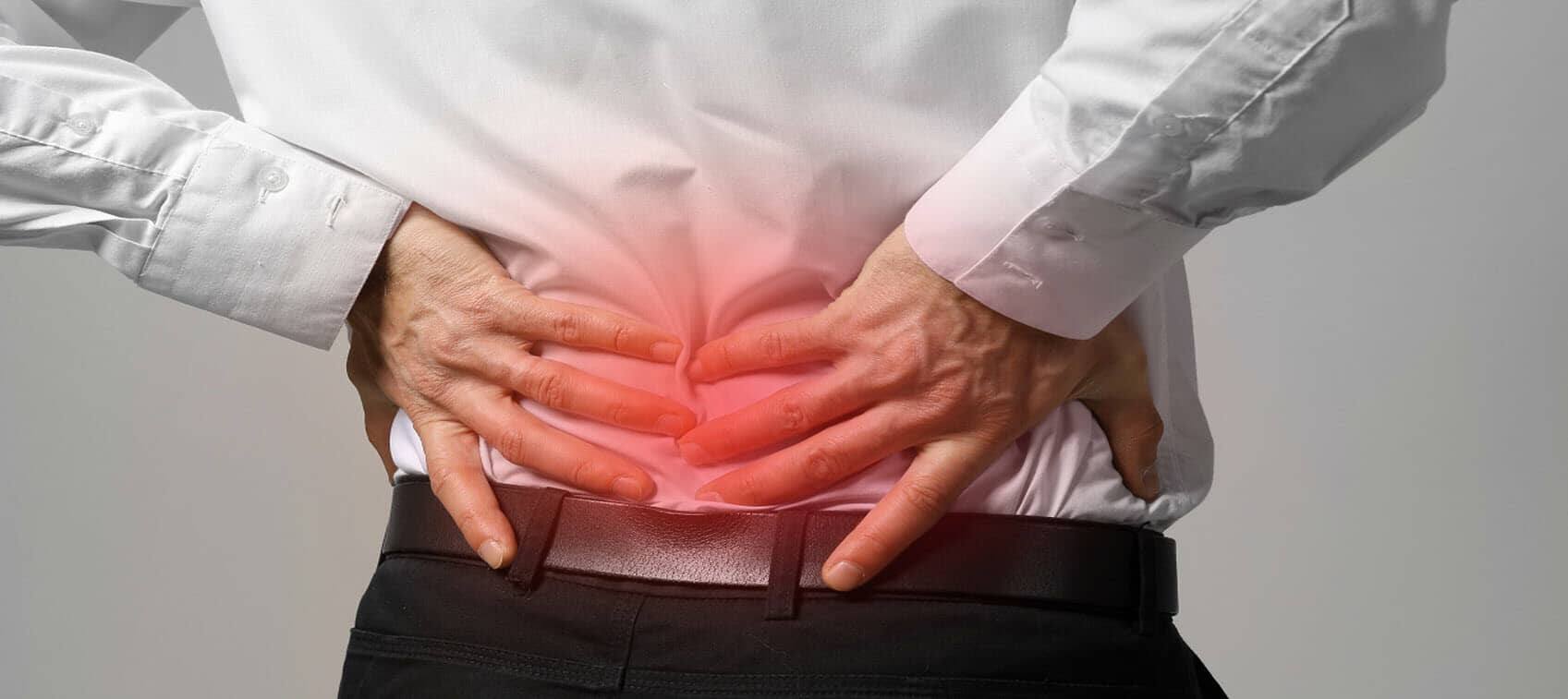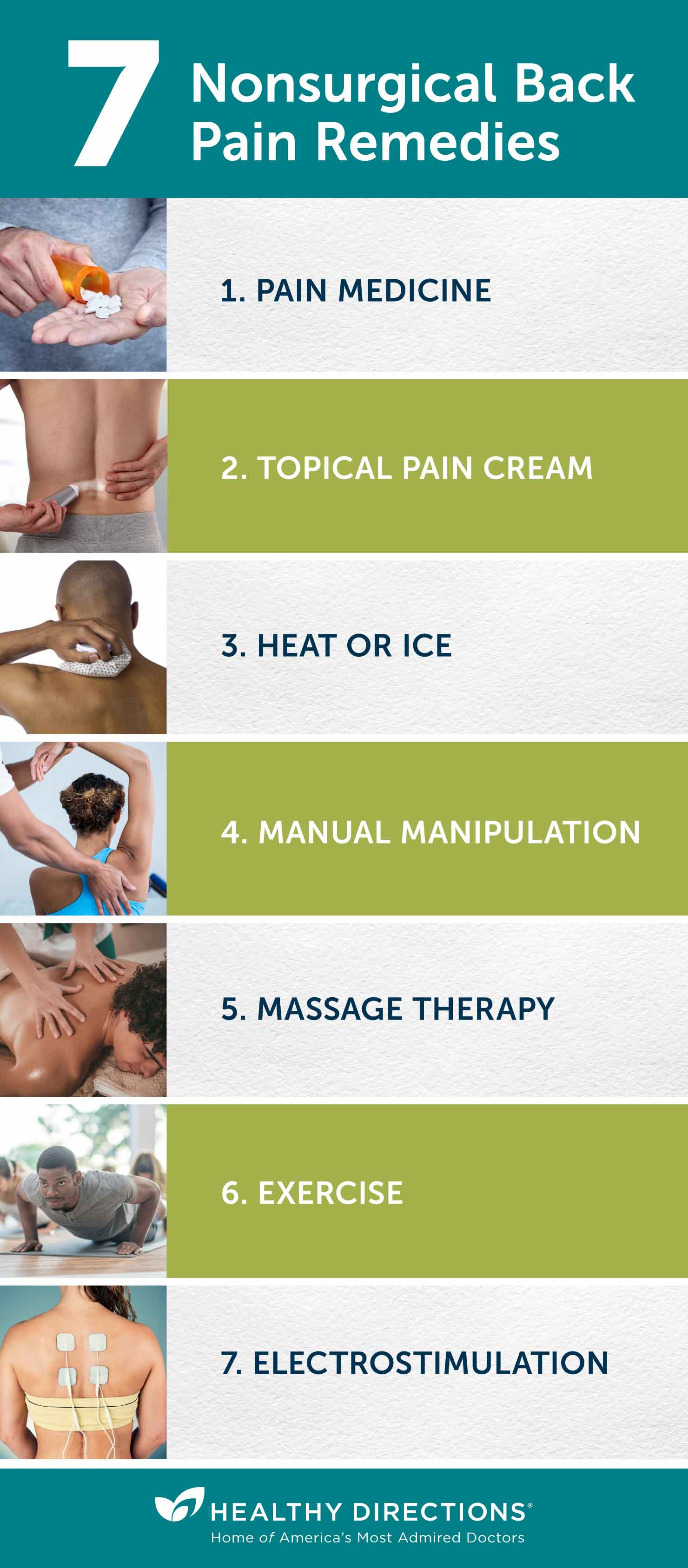
If you’re suffering from lower back pain, you’re not alone! About 80% of people will experience some form of back pain over the course of their lifetime, and low back pain is one of the most common pain complaints.
Why is lower back pain so rampant? One reason is that that there are so many causes of lower back pain: accidents, stress, sprains, having other health disorders (such as cancer), inflammation, arthritis, and poor physical condition. Plus, the obesity crisis in America has fueled the back-pain epidemic.
What Causes Lower Back Pain?
Lower back pain generally falls into four main categories:
- Musculoskeletal: muscle strains, muscle spasms, osteoarthritis, herniated nucleus pulposus, herniated disks, spinal stenosis, or compression fracture.
- Inflammatory: certain types of arthritis including psoriatic arthritis, reactive arthritis, ankylosing spondylitis, as well as inflammatory bowel disease.
- Malignant: bone metastasis from breast, lung, thyroid, or prostate.
- Infectious: osteomyelitis or abscess.
It’s often hard to pinpoint the exact cause of lower back pain. But the following factors can contribute to lower back pain:
- Obesity,
- Weight gain during pregnancy,
- Stress,
- Poor physical condition,
- Bad posture,
- Poor sleeping position.
There are also physical causes of lower back pain including:
- Osteoarthritis,
- A spinal disc herniation or degeneration of the discs between the vertebrae,
- Broken vertebra(e), often due to osteoporosis.
In addition to lower back pain during pregnancy, women can also experience lower back pain due to endometriosis, ovarian cysts, uterine fibroids, or ovarian cancer.
Why Is the Lower Back So Vulnerable to Pain?
Your lower back, also called the lumbar, is made up of five vertebrae. Between these vertebrae are discs that act as cushions, preventing the vertebrae from rubbing together and protecting the spinal cord. It’s nature’s way of protecting you from lower back pain.
So, what causes lower back pain? To understand why pain occurs, picture each disc in your back as a “jelly doughnut” with a gelatinous core surrounded by a fibrous ring. When in its normal, uninjured state, the nerves in your back only run to the outside of each disc. That’s because the gelatinous core of each disk contains specialized cells that can survive without a direct blood supply.
Over time, the discs in your back lose flexibility and the ability to absorb physical forces. When this happens, it increases stress on other parts of the spine, causing the ligaments of your spine to thicken and bony growths to develop on the vertebra that make up your spine. As a result, the disc becomes degenerative whereby there is less space through which the spinal cord and nerve roots may pass.
When a disc degenerates, either because of injury or disease, the makeup of a disc changes and blood vessels and nerves may grow into its interior—causing pain. Plus, herniated disc material from the center of the disc can leak out and push directly on a nerve root, triggering pain.
When someone has lower back pain they also tend to use the back muscles improperly to try to avoid the pain—and those muscles can continue to be sore even after your back has healed. That’s why teaching people with chronic lower back pain how to use these muscles is an important part of any lower back pain treatment.
What Is the Best Lower Back Pain Treatment?
When dealing with any type of pain, including lower back pain, you need to make sure you are dealing with it the most prudent matter. Many people come to see their pain doctor with a lot of misconception and their own ideas on how to manage their lower back pain, including:
- Trying to “tough it out.”
- Avoiding pain medicine out of fear that you will become immune to it.
- Convincing yourself that the pain is just in your head.
- Assuming your doctor understands your pain level.
- Failing to tell your doctor or pharmacist about other medications and supplements you’re taking.
- Taking NSAIDs without first talking to your doctor.
- Failing to understand your pain and the unique treatment plan.
- Not taking advantage of natural or nonpharmacological remedies.
Others use pain pills as the treatment of choice for back pain. While that may seem like an easy back pain remedy, before you reach for oral over-the-counter (OTC) pain relievers, or pharmaceutical pain pills (including opioids), it’s important to understand the dangers they pose. This is especially true if these pills are taken in the wrong dose or used in an uncontrolled manner as a long-term back pain treatment, since they come with a whole host of side effects and can be dangerous.
Nonsurgical Back Pain Remedies
For many people dealing with severe chronic pain, surgery may be the only viable option—although it may not necessarily result in complete pain relief. It is important to have a discussion with your doctor about the risks of surgery, as well as the potential benefits, before opting to take this course of action.
The good news is there are numerous ways to get relief from lower back pain without resorting to surgery. Some of the more common non-surgical treatment options for back pain include:
- Pain Medication: Typical oral pain medications to treat lower back pain include acetaminophen, NSAIDs, oral steroids, and muscle relaxants. Topical OTC and prescription pain relief products also exist.
- Heat or Ice: Heat packs and ice can help to relieve lower back pain. Some people find that alternating between the two works best.
- Manual Manipulation and Message Therapy: This treatment can be applied by an osteopathic doctor, chiropractor, physical therapist, or other qualified allied pain health professional.
- Exercise: A program of back exercises will usually include a combination of core and back strengthening, stretching, and low-impact aerobic exercise.
- Electrostimulation: This includes transcutaneous electrical nerve stimulation (TENS), various types of radiofrequency application, and spinal cord stimulation. Preliminary research suggests spinal cord stimulation (SCS) may help to relieve chronic pain in the lower back but is considered an invasive procedure. There are also many extremely effective ways to address back pain naturally.

Natural Remedies for Back Pain
As a world-renowned pain specialist, patients come to see me from all over the world seeking relief from a variety of pain types, including lower back pain. My philosophy involves using a multimodal combination of pharmacological and nonpharmacological treatments, or multimechanistic (many sided or mechanism orientated) treatment plan that includes natural remedies.
In the case of relatively mild, short-term low back pain I recommend:
- Rest for a limited period,
- A topical (not absorbed into your blood system working where the pain is located) pain reliever like Instaflex Pain Relief Cream,
- Very limited movement at first but then gradual resumption to normal activities as tolerated,
- Alternating heating pad and ice.
For more moderate to severe pain and long-term chronic back pain, there are also other options that can be explored, including but not limited to:
- Chiropractic care,
- Spinal manipulation therapy,
- Acupuncture,
- Massage therapy,
- Herbal supplements,
- Essential oils,
- Capsaicin plasters,
- Physical therapy,
- Pharmacological options,
- Interventional pain block techniques,
- Cognitive behavior therapy,
- Surgical interventions,
- Combinations of the above.
Since lower back pain can be caused by a variety of different things, many people may find relief from a combination of various natural treatments. Also, keep in mind that “one size doesn’t fit all” when it comes to pain management. In other words, pain management is very individualized and just because a treatment works for one patient with back pain does not necessarily mean that it will work for others.
Because pain may be derived from a combination of pain generators, a multimechanistic/multimodal individualized pain management program directed by a multidisciplinary team of healthcare providers is highly recommended.
How to Keep Lower Back Pain from Recurring
One of the best ways to get low back pain relief is to prevent it from occurring in the first place. Here are a few things that you can do to reduce the chance that you will experience lower back pain:
- Stay Healthy and Active: Being active helps to keep your muscles strong which will reduce your chances of experiencing lower back pain. Some of the best exercises to get low back pain relief, and keep it from recurring, include yoga and Pilates.
- Use Proper Lifting Techniques: Lift with your legs, not your back. Improper lifting can be very dangerous and is one of the leading causes of back injury, so you should always try to bend down using the knees and sparing the spine.
- Keep Your Weight Under Control: Excess weight can put a strain on the back and lead to an increased incidence of lower back pain.
- Exercise with Care: Abdominal crunches, bar back squats, double leg lifts, and toe touches can all put a strain on the lower back. To get low back pain relief you want to avoid those exercises.
- Seek medical care if the pain is too intense or lasts more than two weeks.


